The integration of photovoltaics into existing surfaces, devices and envelopes requires new module concepts and thus module manufacturing processes. Curved PV modules can be used in e-vehicle roofs, for example. The prototype of a curved PV car roof was manufactured at Fraunhofer ISE in 2019. In order to be able to manufacture curved PV modules industrially, an industrial laminator as well as the required processes and module concepts are being developed in the "3D" project. In addition, methods for mechanical and electrical characterization are being developed and tested. Solar cell strings are examined by Magnetic Field Imaging (MFI) and conductive adhesives by Dynamic Mechanical Analysis (DMA). | Duration: 02/2021 - 01/2024
more infoResearch Projects
-

Visualization of a PV car roof with shingled solar cells.
-
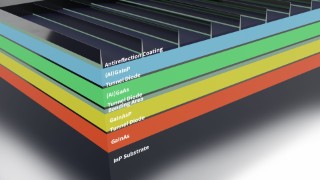
Quantum efficiency measurement of a wafer-bonded 4-junction solar cell.
The primary goal of the 50Percent project is to produce the first multi-junction solar cell with an efficiency value of 50% and a concentrator module with 40% efficiency. The project also seeks to develop measuring technology so that the cells can be measured in accordance with internationally recognized calibration standards. The project aims to impressively demonstrate German PV research excellence. | Duration: 03/2020 - 05/2024
more info -
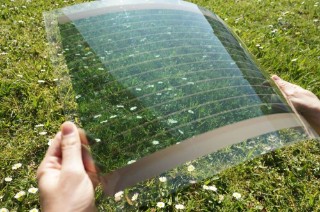
Mock-up of a transparent organic solar module manufactured with a still strongly absorbing organic semiconductor material. In the project, such modules with electrical function and higher transparency are to be manufactured and the technology presented to interested users on the basis of these demonstrators.
Climate change has become a tangible reality in Germany in recent years. Heatwave summers and low precipitation in winters have led to massive problems in agriculture in many places. Protected cultivation under foils is a current trend, causing additional costs and waste problems. In this project, highly transparent organic solar cells will be developed that allow visible light, which is important for plants, to pass through and use the infrared portion to generate electricity. These could make it possible to simultaneously generate the urgently needed solar power for a successful energy and mobility turnaround from the film covers that are intended to protect plants from heavy rain, hail, sunburn and desiccation. | Duration: 09/2021 - 07/2024
more info -
AIIR-Power
AI-assisted design and fabrication of photonic infrared power converters for energy and telecommunication

Photonics and optoelectronics are key technologies for the digitalization. The design of corresponding semiconductor devices as well as the modeling of epitaxial processes can still benefit significantly from artificial intelligence (AI) methods in the context of Industry 4.0. Ubiquitous digitization and automation, as well as the Internet of Things, require constant energy and data streams. The emerging technology of photonic power transmission, also known as power-by-light enables power and data transmission to be combined in a single optical link. By using optical telecommunication wavelengths around 1.5 µm, the applications of such power-by-light systems can be extended to remote locations, enabling unlimited remote power supply. AI-assisted approaches to photonic power converter (PPC) design and fabrication are critical for further cross-industry application of photonic power and data transmission. | Duration: 04/2021 - 03/2024
more info -
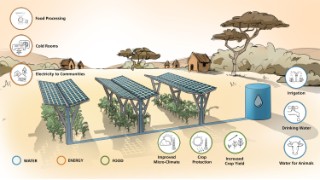
Schematic diagram of a triple land use through agrivoltaics.
The agrivoltaic project in Mali and the Gambia (APV-MaGa) is a research and development project that aims at proofing the technical and economic viability of an integrated triple land-use system in order to contribute to a more ecological and socio-economic sustainable development of the partner countries and in general, the West African economy. Thus, the double land use of agrivoltaics is extended by the range of water management. Furthermore, APV-MaGa aims at uniting agricultural research, socio-economic strategies and solar energy expertise to reveal challenges and opportunities of APV systems and to gain a deeper understanding of synergies and interactions between the Food-Water-Energy-Nexus. | Duration: 08/2020 - 12/2023
more info -
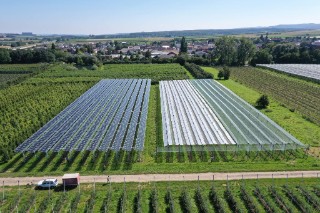
The experimental setup compares five different variants.
The agricultural sector is facing new challenges. In the wake of climate change, strategies must be developed to avoid negative impacts on harvests. Orcharding in Germany is already affected by the consequences of climate change: rising temperatures, changes in precipitation distribution and increasingly frequent extreme weather events such as hail and heavy rain. As a result, commercial fruit growers are increasingly using hail protection nets and foil roofing to prevent quality and yield losses. The project "APV-Obstbau" (Agrivoltaic Orcharding) will investigate to what extent agrivoltaics can replace these protective measures in apple cultivation, which system design makes sense for this crop and in which way the agrivoltaic system affects crop yields. | Duration: 04/2020 - 03/2025
more info -
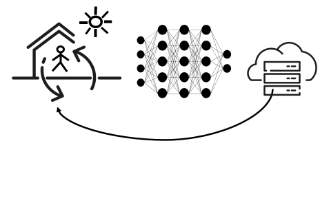
ki-pipeline for adaptive heat pump operation
Heat pumps are an effective solution for reducing energy consumption and the environmental impact of buildings, and for introducing renewable energy into the heat supply. However, the actual efficiency of heat pumps in practice does not always meet expectations. In addition to high occurring heat losses, the energy efficiency is reduced by an inappropriate system design, by misparameterization of the heat pump control and by undetected operating deficits. Therefore, the subject of the "AI4HP" project is the development of a new generation of "intelligent heat pumps", which adaptively adjust to changing boundary conditions with the help of artificial neural networks and thus increase energy efficiency while maintaining user comfort. | Duration: 09/2021 - 08/2024
more info -
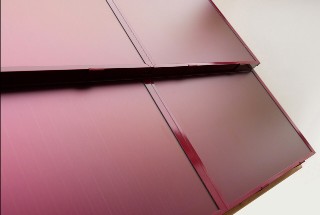
Solar roof modules with Morpho-Color® color coating in a classic roof covering.
The potential for roof-integrated photovoltaics is significant. According to a study by Fraunhofer ISE, building-integrated photovoltaics alone is estimated to have a technical potential of 1,000 GW for Germany. The majority of this segment accounts for roof surfaces. Considering this background, cost-effective, visually attractive and easy-to-install photovoltaic solutions for roof integration will become particularly popular in the future. In the "Baldachin" project, we are working with our partners to develop an innovative solar roof element for next-generation building-integrated photovoltaics that follows the shape and color of classic roof tiles at no visible solar cells. | Duration: 07/2021 - 06/2024
more info -
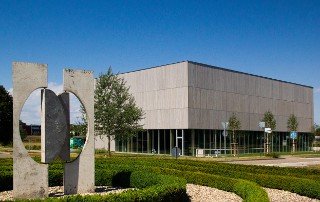
The Regional Innovation Center for Energy Technology (RIZ Energie) at Offenburg University of Applied Sciences.
The construction industry has been dealing with Building Information Modeling (BIM) for several years. While this method is increasingly used in architectural offices for optimized planning, BIM methods are only slowly finding their way into the planning of technical building equipment , the execution and the operational phase of buildings. The research project "BUiLD-DIGITiZED" develops BIM methods for the commissioning and operational optimization of technical building equipment systems and demonstrates them on a lowest-energy building. In this way, the project provides an impetus for the broad application of BIM methods from design planning through execution to commissioning. This allows for BIM methods to be used in a targeted manner to significantly improve workplace quality and energy efficiency. | Duration: 07/2020 - 06/2023
more info -
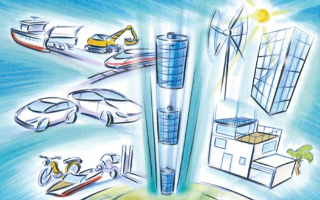
The "BetterBat" project addresses the interface between battery technology and its potential use in an application. "BetterBat" thus explicitly focuses on the user side and its systemic application-specific requirements, enabling target-oriented research and development, shortening the time-to-market accordingly and reducing the risk of failing to meet market requirements. "BetterBat" is intended to provide answers to the following questions, for example: For which applications can battery-electric solutions be considered today or in the future? Which battery technology is suitable for which application? What are the strengths and weaknesses and where might further research or funding be required? The work packages required to answer these questions are shown schematically in the figure below. | Duration: 03/2021 - 02/2024
more info